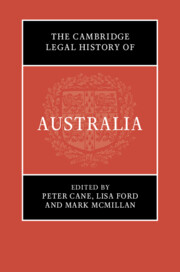Book contents
- The Cambridge Legal History of Australia
- The Cambridge Legal History of Australia
- Copyright page
- Contents
- Figures
- Maps
- Contributors
- Maps
- 1 Editors’ Introduction
- I Cultures of Law
- II Public Authority
- III Public Authorities in Encounter
- IV Land and Environment
- 13 Settlement and Dispossession
- 14 Australian Land Law
- 15 Aboriginal Land Rights, Subjection and the Law
- 16 Land Justice
- 17 Environment
- V Social Organisation
- VI Social Ordering
- VII Reckonings
- Index
17 - Environment
from IV - Land and Environment
Published online by Cambridge University Press: 04 August 2022
- The Cambridge Legal History of Australia
- The Cambridge Legal History of Australia
- Copyright page
- Contents
- Figures
- Maps
- Contributors
- Maps
- 1 Editors’ Introduction
- I Cultures of Law
- II Public Authority
- III Public Authorities in Encounter
- IV Land and Environment
- 13 Settlement and Dispossession
- 14 Australian Land Law
- 15 Aboriginal Land Rights, Subjection and the Law
- 16 Land Justice
- 17 Environment
- V Social Organisation
- VI Social Ordering
- VII Reckonings
- Index
Summary
Since 1788 settler law has provided a means to either prevent or progress certain forms of environmental change, according to the values and needs of the settler state. These exploitative interests of the settler state were in sharp contrast to the approach of First Nations law, of caring for country, as reflected in the ancient and continuing culture of Indigenous peoples. This chapter examines the shifting nature and focus of environmental law from the exploitative pioneering phase of the late eighteenth and nineteenth centuries, the national development and wise use of resources that followed Federation, and concludes with the rise of modern environmentalism from the 1960s. The statutes and cases examined in this chapter range from the free selection and public health acts of the colonial period, to the more recent Environment Protection and Biodiversity Act 1999 (Cth) and Telstra Corporation v Hornsby Shire Council (2006). The historical record suggests a reactionary pattern of environmental exploitation giving rise to settler environmental anxieties that stimulate legislative intervention. Despite the promise of the wave of environmental legislation of the 1970s and 1980s, Australia’s State, Territory and Federal environmental laws have proven to be relatively weak in restraining this reckless pattern of political expediency, developmentalism and short-sightedness.
Keywords
- Type
- Chapter
- Information
- The Cambridge Legal History of Australia , pp. 402 - 430Publisher: Cambridge University PressPrint publication year: 2022



